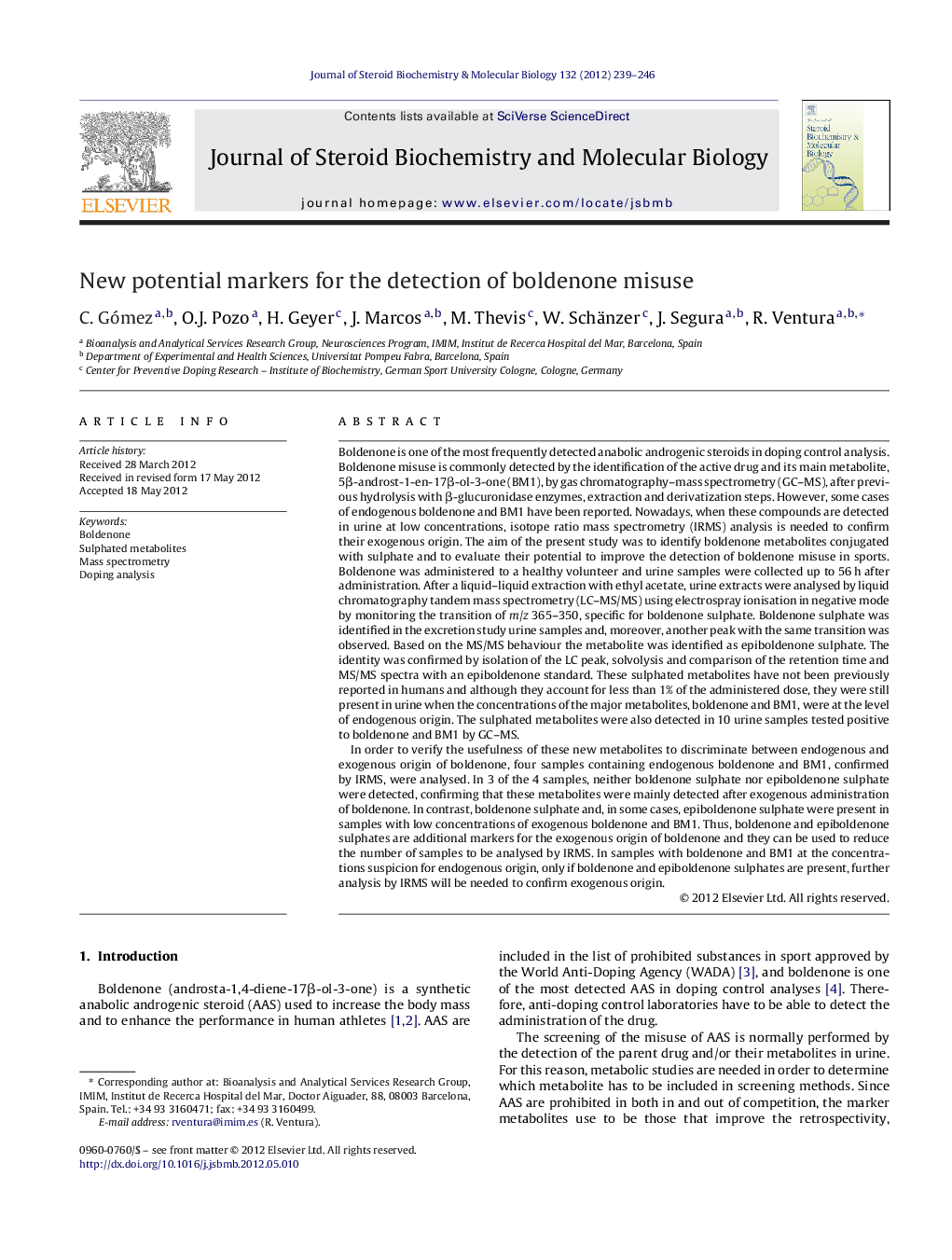| کد مقاله | کد نشریه | سال انتشار | مقاله انگلیسی | نسخه تمام متن |
|---|---|---|---|---|
| 1991606 | 1541018 | 2012 | 8 صفحه PDF | دانلود رایگان |

Boldenone is one of the most frequently detected anabolic androgenic steroids in doping control analysis. Boldenone misuse is commonly detected by the identification of the active drug and its main metabolite, 5β-androst-1-en-17β-ol-3-one (BM1), by gas chromatography–mass spectrometry (GC–MS), after previous hydrolysis with β-glucuronidase enzymes, extraction and derivatization steps. However, some cases of endogenous boldenone and BM1 have been reported. Nowadays, when these compounds are detected in urine at low concentrations, isotope ratio mass spectrometry (IRMS) analysis is needed to confirm their exogenous origin. The aim of the present study was to identify boldenone metabolites conjugated with sulphate and to evaluate their potential to improve the detection of boldenone misuse in sports. Boldenone was administered to a healthy volunteer and urine samples were collected up to 56 h after administration. After a liquid–liquid extraction with ethyl acetate, urine extracts were analysed by liquid chromatography tandem mass spectrometry (LC–MS/MS) using electrospray ionisation in negative mode by monitoring the transition of m/z 365–350, specific for boldenone sulphate. Boldenone sulphate was identified in the excretion study urine samples and, moreover, another peak with the same transition was observed. Based on the MS/MS behaviour the metabolite was identified as epiboldenone sulphate. The identity was confirmed by isolation of the LC peak, solvolysis and comparison of the retention time and MS/MS spectra with an epiboldenone standard. These sulphated metabolites have not been previously reported in humans and although they account for less than 1% of the administered dose, they were still present in urine when the concentrations of the major metabolites, boldenone and BM1, were at the level of endogenous origin. The sulphated metabolites were also detected in 10 urine samples tested positive to boldenone and BM1 by GC–MS.In order to verify the usefulness of these new metabolites to discriminate between endogenous and exogenous origin of boldenone, four samples containing endogenous boldenone and BM1, confirmed by IRMS, were analysed. In 3 of the 4 samples, neither boldenone sulphate nor epiboldenone sulphate were detected, confirming that these metabolites were mainly detected after exogenous administration of boldenone. In contrast, boldenone sulphate and, in some cases, epiboldenone sulphate were present in samples with low concentrations of exogenous boldenone and BM1. Thus, boldenone and epiboldenone sulphates are additional markers for the exogenous origin of boldenone and they can be used to reduce the number of samples to be analysed by IRMS. In samples with boldenone and BM1 at the concentrations suspicion for endogenous origin, only if boldenone and epiboldenone sulphates are present, further analysis by IRMS will be needed to confirm exogenous origin.
► A previously unreported boldenone metabolite is detected in human urine.
► This metabolite has been identified as epiboldenone sulphate.
► A method for the detection of this metabolite and boldenone sulphate is developed.
► The method can help to discern between endogenous and exogenous origin of boldenone.
Journal: The Journal of Steroid Biochemistry and Molecular Biology - Volume 132, Issues 3–5, November 2012, Pages 239–246